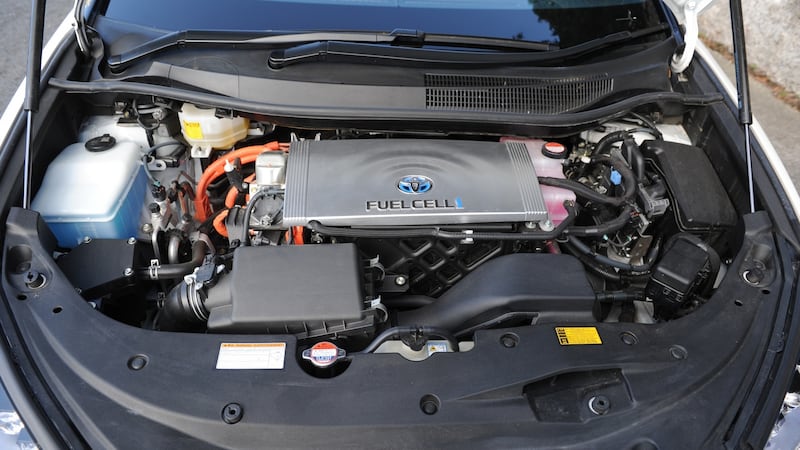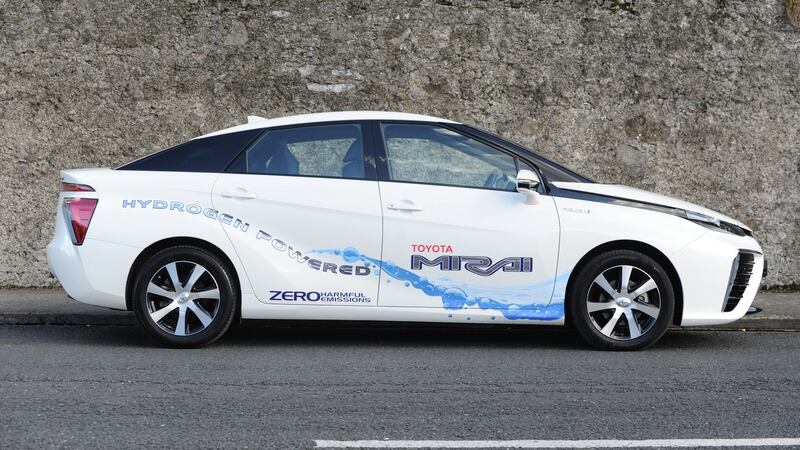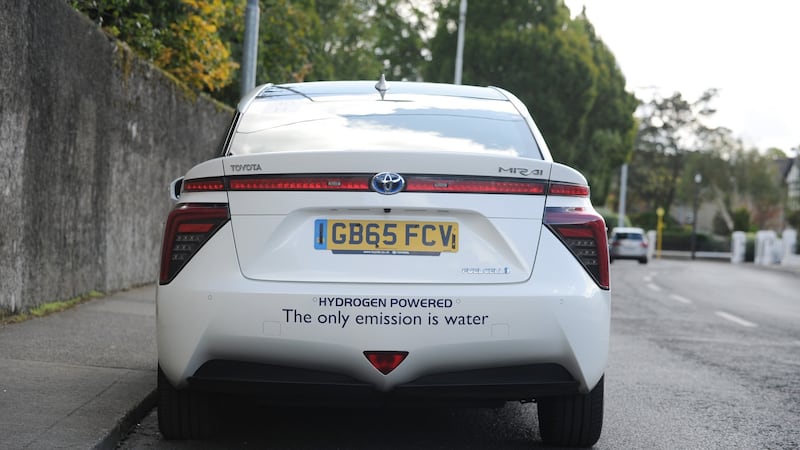The arrival in Ireland of the first hydrogen-fuelled car was not for a big launch of a soon-to-be-available model. Its makers shipped it here to provoke debate about the merits of the technology, the benefits to the environment arising from its fuel source, and to consider what it might take to become a mass-market option.
Cold economic analysis in all likelihood would make it a non-runner. Factor in environmental benefits and convenience, and many would contend it has become “a maybe” – and yet some major economies are backing its deployment and many leading manufacturers.
The end of the car fuelled by fossil fuels is on the horizon. The electric car (EV) in all forms seems to have already won the race to replace it. But giant carmakers are hedging their bets by also backing the fuel cell vehicle (FCV) on the basis it’s real, on the road, and could one day challenge EVs in the race for pollution-free roads if more stations are built to fuel them. The infrastructure is the big gap in the equation of viability – it costs between €500,000 and €2 million to build a fuel station.
Advances in hydrogen storage, fuel cell stacks and batteries have allowed engineers to shrink those components so they fit neatly inside a sedan – such as Toyota’s Mirai, which made its debut on Irish roads recently. The enhancements address safety concerns, while costs are declining. The Mirai, nonetheless, would set you back €80,000 if it was on sale here.
So is hydrogen the motoring fuel of the future?
The hydrogen car has three big pluses to commend it. The combining of hydrogen and oxygen in the fuel cell stack provides an energy source (electricity) that has zero harmful emissions (water is the only by-product, stored in a small tank and released when stationary). It has a range of more than 550km (300 miles) and refuelling can be completed in three minutes. Combining 50L of water and 5kg of hydrogen gas gives a 550km range – current costs vary from €2 to €9 per kg.
To ensure zero emissions applies to all aspects of the technology, production of hydrogen can be done by a process of electrolysis using “renewables” such as wind, solar or hydro power.

What is it like to drive?
Complete with distinctive oxygen intake vents at the front, the Mirai has the attributes of a standard EV or hybrid like the Prius. Its prime asset from a driving experience is the smoothness and user-friendly technology. Allied to that is swift acceleration, and much lower noise compared to cars with conventional (and invariably polluting) combustion engines.
Any safety issues?
Safety concerns about hydrogen have been addressed – end of story. The Mirai has been built on the back of almost 20 years of know-how from developing hybrid technology, notes Mark Teevan, Toyota Ireland's director of strategy, innovation and corporate affairs.
Where might the hydrogen car fit in the transport mix?
The Mirai confirms hydrogen-fuelled cars, buses and trucks are going to be part of the mix in the electrification of motoring that “will increase dramatically after 2020”, Teevan says – and this will coincide with the demise of petrol and diesel cars.
Moreover, China has announced plans to join an expanding list of countries phasing out fossil fuel-burning cars including the UK, France, Norway and India. Separately, a growing number of cities have announced bans on diesel-fuelled cars kicking in during the 2020s.

What are manufacturers and fuel companies doing?
Toyota produced the world’s first dedicated mass-produced hydrogen FCV. A total of 3,000 Mirai vehicles a year are being produced and it is for sale in Japan, the US and seven EU countries. From 2020, the second-generation Mirai (rising to production of 30,000 cars per year) is expected to sell for about €40,000, and to achieve price parity with the diesel car by 2025.
Honda, Hyundai and GM have all developed their own hydrogen-fuelled models, which are on the road. Mercedes-Benz will unveil a production-ready version of its promised hydrogen fuel SUV in the coming days. GM this year supplied the US Army with a fuel-cell pick-up, and is working with Honda to introduce a long-range fuel-cell SUV next year. BMW is to launch a hydrogen fuel-cell car in the next five years for "larger model series and long distances" and "a low-volume fuel-cell car in 2021, with wider availability in 2025".
Part of the industry strategy is to have a finger in the pie, so if a shift over to hydrogen happens, they will be in a position to scale up quickly.
Shell is part of a public-private consortium planning 400 hydrogen filling stations across Germany by 2023, together with partners including its French rival Total.
What will the car showroom look like over the next few years?
The decarbonised motoring world is about to throw up a remarkably diverse – if not bewildering – mix of EVs and FCVs, a trend which is set to accelerate from 2020. EVs are best suited to shorter journeys and urban commuting, Toyota believes. EVs with a 500km range are imminent, but with bigger, heavier batteries that need long charging times.
There is no one totally correct solution to the future of transport. EVs will be good for short journeys; hybrid and plug-in hybrid for longer use, and fuel cells for long-distance and larger vehicles.

What are governments and the EU doing?
The EU has committed more than €650 million to help expand hydrogen infrastructure, and governments in Germany, Denmark and the UK have led the way in state support for the provision of infrastructure. An Irish network to ensure viability would necessitate stations along our motorways and in all our cities.
The Government’s position on hydrogen transport?
The Government’s attitude to the hydrogen option can be summarised as follows: cost of a car is prohibitive, it’s not a mass-market option, and anyway the costs of refuelling infrastructure is prohibitive for the foreseeable future.
Its environmental credentials don’t get a look-in in that scenario.
The official line: “There are no immediate plans to establish a hydrogen refuelling network. Hydrogen is not expected to deliver mass-market uptake before 2030 as the costs of the refuelling infrastructure and associated vehicles are likely to remain prohibitive until the middle of the next decade.
“Consequently, the cost of the infrastructure is greatly disproportionate to current demand. However, the feasibility of establishing a hydrogen refuelling network will be regularly assessed to take account of changes in technological development and market uptake,” a Department of Transport spokesman said.












